Official Name
Охрид (Ohrid). In ancient Roman times, the place was known as Lichnidos. After the fall of the Roman Empire it was renamed Ohrid. Ever since it's known as Ohrid. Note that the 'h' is pronounced as the [ ch ] in the Scottish word [ loch ] (phon: χ).
Location
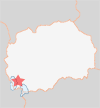
| ||
| Ohrid |
Ohrid lies in the south-west corner of Macedonia on the shore of ез. Охрид (Lake Ohrid). A few words about Lake Ohrid: It's a tectonic lake and very, very old. The water surface is 268 km² big, with one third of the lake belonging to →Albania. Except for the northern shore, the lake is surrounded by more or less high mountains. The lake itself has an altitude of 695 metres. The maximum depth is 294 metres, making it the deepest lake in the Balkans. The lake is fed by the water coming from the mountains. The Чрн Дрим (Črn Drim) river starts from Lake Ohrid and flows through Albania before discharging into the Adriatic sea. Fish stocks in the lake are quite impressive.
The town of Ohrid stretches along a small bay in the middle of the eastern shore. Parts of the historic centre are built on the top of a small mountain. The lake itself as well as the historic importance of Ohrid make this place a real mecca for tourists.
Population
Around 27,000 inhabitants.
Orientation
The old fortress, built on the top of a spur, towers above the historic town centre, which stretches all the way down to the harbour. A small plain between the mountains is used for the newer districts of the town. The modern centre as well as the outskirts are very spacious.
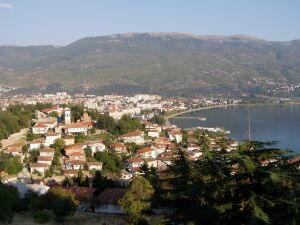
| ||
| A view from the fortress over Ohrid |
The historic core is different: It's rather hilly and has very narrow lanes and many stairs. Here and there, in the old town as well as on the top of the rocks high above the lake, there are some churches. Some of them are quite hidden. Parts of the fortress as well as most of the churches are well preserved or were restored during the last years.
From the harbour, dead straight бул. Македонски Просветители (Bulevar Makedonski Prosvetiteli, Boulevard of Macedonian Enlightenment) leads away from the lake. This is Ohrid's main road. A few metres away from the harbour, the vibrant pedestrian zone Св. Климент Охридски (Sv. Kliment Ohridski) with all of its shops and street cafés is very popular with visitors and locals. On the left (when coming from the lake) starts the narrow old town, with many restaurants lining up along the lakeside. Right of the pedestrian zone there's the less beautiful, new Palace of Culture, the post office and the bus terminal. It's fun to explore all the small lanes of the old town up to the fortress. Seeing everything takes a couple of hours. Needless to say that the old town is crowded with tourists in summer.
History
The location of Ohrid couldn't be better: The climate, the large lake (=fish!), a plain that can be used for agriculture and a spur to build a fortress form perfect conditions for a town. The fortress was used to control the Roman trade route Via Egnatia, which connected the Adriatic Sea with Aegean Sea. Hence, the oldest ruins are from Roman times.
During the Byzantine and Ottoman occupation, Ohrid became the centre of Slavic culture. The first Slavic university was founded here in the year 893 (!) by the famous Bishop Kliment of Ohrid. He was a disciple of St Cyril and St Methodius; both of them christianized the Slavic world starting from Ohrid and died a few years before the foundation of the university. In the 10th century, Ohrid even became the capital of the mighty →First Bulgarian Empire, but this was only for a few years. Ever since, Ohrid was the residence of the archbishop, which shouldn't change until 1767. All in all, around 300 churches were erected and numerous precious art treasures created. Unfortunately, a lot of it was gradually destroyed or painted over during the Ottoman occupation.
After shaking off the Ottoman yoke, Ohrid started to restore its former glory. Since 1958, it's the centre of the Macedonian-Orthodox archbishopric again. The Macedonian church eventually separated from the Serbian-Orthodox church in 1967. So to say, Ohrid is the religious centre of the Macedonian-Orthodox church. Tourism is the major economic factor in and around Ohrid, and thanks to the increasing number of visitors, the town is booming. It's not the Sea, and there aren't many sandy beaches, but visitors will find almost everything they can find in more famous places such as →Dubrovnik - culture, mountains, great weather, clear water etc. And an appropriate infrastructure. It should be mentioned that the old town was declared UNESCO World Heritage.
Getting there / transportation
The international airport is called Мислешево (Misleshevo) and lies near the northern tip of the lake. Direct flights from Zürich, Düsseldorf and other big cities in middle Europe go to Ohrid - at least in summer. There seem to be flights from the capital →Skopje as well, but since it takes 4 hrs only to get there by bus it would be a waste of money. Buses to Ohrid start from the bus terminal below Vale fortress in Skopje. There are several daily buses. The shortest route is via Кичево & Тетово (Kičevo and Tetovo). Some buses stop in Tetovo, others just pass the city. Without a stopover, it takes 3½ hrs, with a stopover it's one hour more. The fare is 340 MKD (less than € 6) per person. Some buses go via Битола & Прилеп (Bitola and Prilep), which is quite a long way, so it takes much more time and the fare is higher.
The bus terminal lies in the new town of Ohrid, but it isn't far to the centre. Especially during the summer months it's wise to buy bus tickets in advance, since the buses fill quickly. There are even direct buses to →Belgrade. Local buses go everywhere - there are many daily buses to →Sveti Naum in the south. These buses stop right in front of the border crossing to →Albania first before they continue to Sveti Naum. The ride takes more than 30 minutes, the return fare is 180 MKD (€ 3). The route is very scenic.
Ohrid offers more than 30 historic monuments - in combination with a breathtaking landscape. A few words about some of the sights:
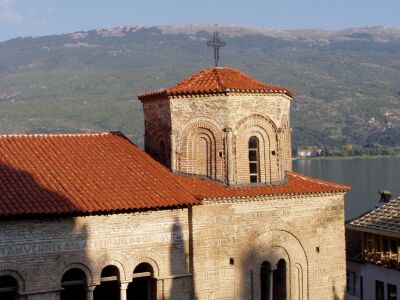
| ||
| Sveti Sofija Church in the heart of the old town |
Churches, churches, churches - the entire old city is dotted with churches, underlining Ohrid's role as the centre of the Macedonian-Orthodox church. Although the town was ruled by the Ottomans for many centuries, almost no traces of the islamic intruders are left. One of the bigger churches of Ohrid is called црква Света София (Sveti Sofija Church), It was built during the 11th century and used as a mosque for a long time. There are beautiful examples of icon painting inside the church. Admission fee is 100 MKD (students 30).
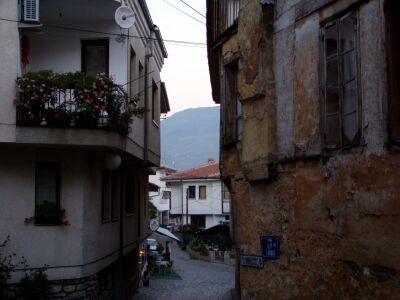
| ||
| Inside the old town of Ohrid |
The old town is characterized by countless narrow, winding lanes. Many lanes are too narrow for cars, and so it's possible to slowly explore the area on foot. Some small beaches can be found along the shore, but many of them are the courtesy of hotels. There's no need to starve in Ohrid: Countless restaurants, many of them specializing in the famous Ohrid trout and some of them in pseudo-Italian food, can be found all over the old town.
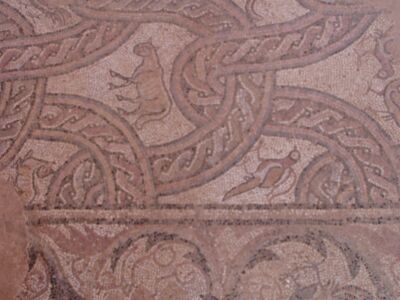
| ||
| Ancient Roman mosaic in an early Christian Basilica |
Not far from the fortress and hidden in the forest lie the Roman ruins of Ohrid - among them the remainings of an amphitheatre and the ruins of an early Christian Basilica built during the 5th century. There's not much left of the Basilica except for the well-preserved mosaics, which are protected by a makeshift roof and can be seen from a wooden foodbridge.

| ||
| The newly restored church of Sv Pantelejmon |
When looking from the ruins of the Basilica to the lake, you will notice the recently rebuilt Свети Пантелејмон (Sveti Pantelejmon Church) (sveti means holy). This church is probably the oldest church of Ohrid. Inside the church, St Kliment (see the chapter on history above) was buried, but later on the corpse was transferred to the Sv. Sofija Church.

| ||
| The citadel of Ohrid offers stunning views |
High above the old town on a cape, Горни Сарај (Mountain Fortress) aka Samuel Citadel towers over the lake and the town. The outer walls have been rebuilt, but inside the citadel there's nothing left but a few foundations. It's possible to climb the outer wall and walk around to enjoy the 360° panorama. Just for the stunning view it's definitely worth to climb the hill and the citadel.
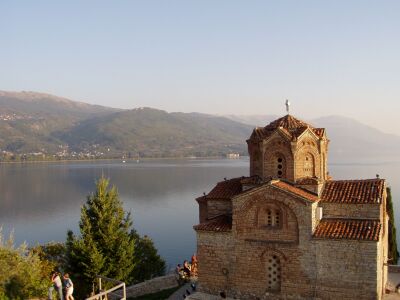
| ||
| Outside the old town atop a rock stands Kaneo Church |
When you walk out of the old town all the way along the lakeside, you will soon get to a small cape, where the beautiful Св. Јован Богослов Канео (St. John Bogoslov-Kaneo Church), shortly called Kaneo Church, towers a few dozen metres above the lake on the top of a large rock. From the church, it's possible to see almost the entire lake. Below the church, there's a stony beach and some cliffs. Admission fee to the church is 100 MKD.
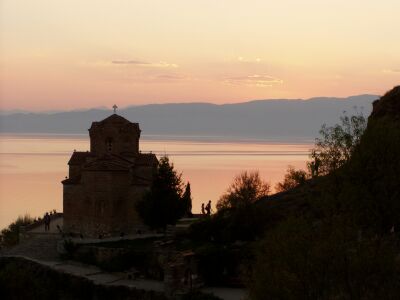
| ||
| Kaneo Church and Lake Ohrid at dusk |
Kaneo church is an excellent place for a nice walk along the lake. And the view from there is just great. It takes around 20 minutes to walk there from the old town. Since most of the way to the church is out of town, it's getting pitch-black at night, so it's better to walk back early enough.
When you drive along the lakeside southwards for around 30 kilometres, you will first notice countless hotels on the beach. Among them is a hotel which should get a prize for it's fine name: That's Hotel Beton (beton means 'concrete', as in concrete floor, in German as well as in Slavic languages). And that's exactly what it looked like. By the way, next to the 'Concrete Hotel' stands 'Hotel Granite'. The further you get to the south, the wilder the landscape gets. Huge mountains arise to the left of the road. That's the Галичица (Galičica) mountain range and one of Macedonia's three national parks. The highest peak is 2,288 m high. Behind the mountains, there's ез. Преспа (Lake Prespa), where the Macedonian, Albanian and Greek border meet. Lake Prespa is larger than lake Ohrid, but the average depth is 12 metres only.
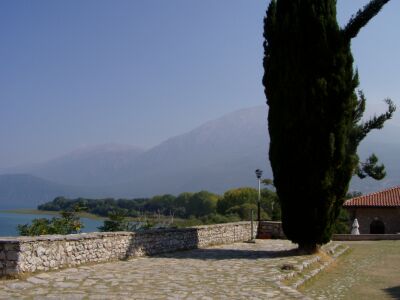
| ||
| A view from Sveti Naum to the Galičica mountains |
The small village at the southern tip of lake Ohrid is called Свети Наум (Sveti Naum, Hl. Naum). A few hundred metres above the village, there's the border crossing to Albania. A few kilometres further to the west, the first bigger Albanian town of Pogradec stretches along the lakeside. Sveti Naum is just a small village, but there's a highly interesting monastery right on the beach and a few kilometres outside the village.
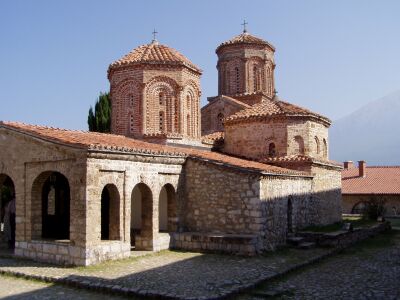
| ||
| The church inside Sveti Naum monastery |
The church inside the monastery was built during the 17th century, but the first church was already built around the year 900. St Naum was buried in that church in 910. The tiny and narrow church features countless frescoes inside. Most of the expressive frescoes were painted in the 19th century - there's not a single spot which is not covered by the paintings. Admission fee is 39 MKD. The monastery around the church is now used as a hotel - as a luxury hotel, to be exactly. As far as I've heard a room for one night costs around € 100. There are numerous food stalls and souvenir vendors lining up along the small path between the monastery and the bus stop. Buses to and from Ohrid via the border crossing leave from the entrance gate.
In contradiction to the capital →Skopje, there's no lack of accommodation in Ohrid. When arriving by bus (and there aren't many alternatives), some locals approach offering private rooms. Which is not a bad idea. We paid 720 MKD (€ 12) for a large, new and spotless clean double room. The landlord was very friendly and not importunate at all. He patiently explained how to get around in Ohrid. Here's his address: Lazo Nikodinoski, ul. Lazo Trposki 14, 6000 Ohrid. Tel.: (046)-264 290. E-Mail: jewelofmacedonia[ at ]gmail [ dot ] com. It's a 10 minutes walk from the bus station in the new town. Lazo speaks English very well. Of course there are many hotels in Ohrid as well.
- www.ohrid.com.mk Official and extremely helpful website of Ohrid. Partially weird English (as in this website!?) but really useful.
Do you have or do you know a good website about Ohrid? Don't hesitate, let me know! After checking it, I would love to add it to the link list. You can submit a link by using the →contact form. Note that commercial websites will be treated differently.
©2024 Europe-East.com

 Albania
Albania Macedonia
Macedonia